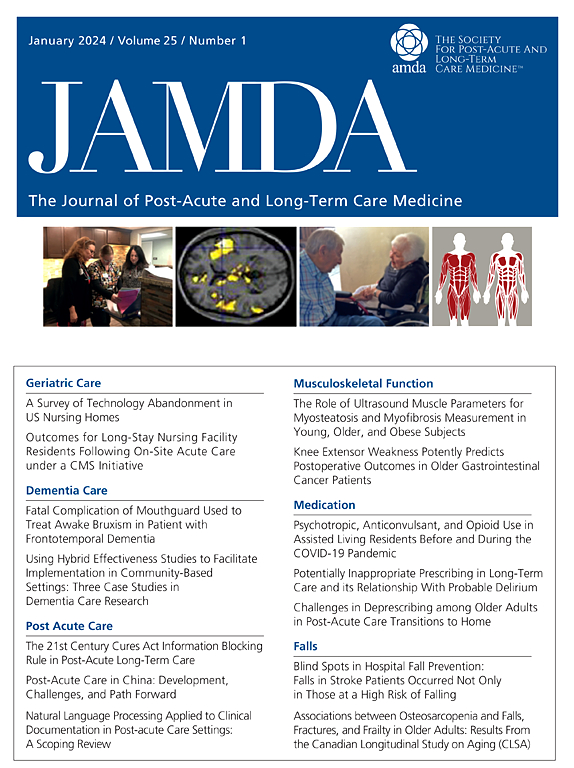慢性护理中老年人吞咽困难康复的决策模式:一项横断面研究。
IF 4.2
2区 医学
Q2 GERIATRICS & GERONTOLOGY
Journal of the American Medical Directors Association
Pub Date : 2025-07-19
DOI:10.1016/j.jamda.2025.105751
引用次数: 0
摘要
目的:探讨慢性护理期老年人吞咽困难康复过程中训练、环境调整和牙科干预等决策的相关因素。设计:探索性横断面研究。背景和参与者:2018年至2023年期间,日本关东地区通过牙科家庭护理接受吞咽困难康复的依赖护理的老年人。方法:回顾性收集临床资料。关键变量包括接受干预的类型、年龄、性别、功能性口服摄入量表(FOIS)、渗透-吸入量表和Charlson合并症指数。根据年龄、虚弱程度、FOIS评分和居住环境,采用k-means聚类方法将患者分为3组。进行组间比较以评估干预策略和持续时间的差异。结果:242例患者,平均年龄83.3岁;38.4%为男性)。56.6%的患者接受了培训,90.1%的患者接受了环境调整(例如,姿势调整:30.7%,饮食和食物指导:89.4%),26.4%的患者接受了牙科干预。聚类分析显示,年轻的管饲患者,其中许多人住在家里,更有可能接受培训(P < .001),干预持续时间更长(P < .001),而老年患者更多地接受补偿策略(P = .471)。结论和意义:在慢性吞咽困难康复中,训练并不总是优先考虑的。干预措施的选择似乎受到患者特征的影响,如年龄、口服摄入状况和其他临床条件。环境调整是最常见的干预措施,突出了补偿策略在依赖护理的老年人中的重要性。本文章由计算机程序翻译,如有差异,请以英文原文为准。
Patterns of Decision Making in Dysphagia Rehabilitation for Older Adults in Chronic Care: A Cross-Sectional Study
Objectives
To explore factors associated with decision making regarding training, environmental adjustments, and dental interventions in dysphagia rehabilitation for care-dependent older adults in the chronic care phase.
Design
Exploratory cross-sectional study.
Setting and Participants
Care-dependent older adults receiving dysphagia rehabilitation via dental home care between 2018 and 2023 in the Kanto region of Japan.
Methods
Data were retrospectively collected from clinical records. Key variables included types of intervention received, age, sex, Functional Oral Intake Scale (FOIS), Penetration-Aspiration Scale, and Charlson Comorbidity Index. Patients were classified into 3 clusters using k-means clustering based on age, frailty, FOIS score, and residential environment. Group comparisons were performed to evaluate differences in intervention strategies and duration.
Results
A total of 242 patients (mean age: 83.3 years; 38.4% male) were included. Training was implemented in 56.6% of patients, environmental adjustments in 90.1% (eg, posture adjustment: 30.7%, eating and food guidance: 89.4%), and dental interventions in 26.4%. Cluster analysis showed that younger, tube-fed patients, many of whom were living at home, were more likely to receive training (P < .001) and had longer intervention durations (P < .001), whereas older patients more often received compensatory strategies (P = .471).
Conclusions and Implications
In chronic-phase dysphagia rehabilitation, training is not always prioritized. Intervention choices appear to be influenced by patient characteristics, such as age, oral intake status, and other clinical conditions. Environmental adjustments were the most common intervention, highlighting the importance of compensatory strategies in care-dependent older adults.
求助全文
通过发布文献求助,成功后即可免费获取论文全文。
去求助
来源期刊
CiteScore
11.10
自引率
6.60%
发文量
472
审稿时长
44 days
期刊介绍:
JAMDA, the official journal of AMDA - The Society for Post-Acute and Long-Term Care Medicine, is a leading peer-reviewed publication that offers practical information and research geared towards healthcare professionals in the post-acute and long-term care fields. It is also a valuable resource for policy-makers, organizational leaders, educators, and advocates.
The journal provides essential information for various healthcare professionals such as medical directors, attending physicians, nurses, consultant pharmacists, geriatric psychiatrists, nurse practitioners, physician assistants, physical and occupational therapists, social workers, and others involved in providing, overseeing, and promoting quality

 求助内容:
求助内容: 应助结果提醒方式:
应助结果提醒方式:


